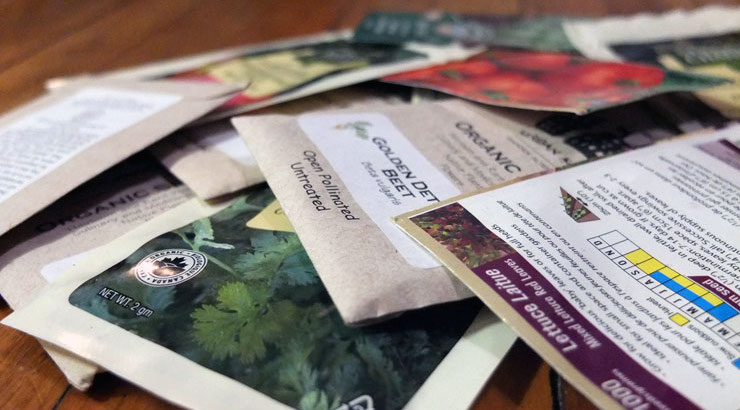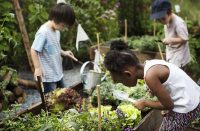Over one hundred workshops, demonstrations and interactive sessions take place at the annual Hillside Festival in Guelph, Ontario amid the music of the festival’s five stages.
Among DIY, active living, arts, music, food and environmental workshops on offer, I attended a days worth of seedy – in a good way – sessions on sprouting, rain gardens, micro-farming and seed saving. Here are some of the ways I learned to grow healthier food, tame water run-off and get the most out of my garden.
Over one hundred workshops, demonstrations and interactive sessions take place at the annual Hillside Festival in Guelph, Ontario amid the music of the festival’s five stages.
Among DIY, active living, arts, music, food and environmental workshops on offer, I attended a days worth of seedy – in a good way – sessions on sprouting, rain gardens, micro-farming and seed saving. Here are some of the ways I learned to grow healthier food, tame water run-off and get the most out of my garden.
Sprouting
It’s about as local as you can get: your own kitchen. And not only that, it’s the original just add water mix. Sprouting starts with a handful of seeds and as little as a glass jar and straining mesh. With a little care – proper rinsing and draining – you too can have super-nutritious sprouts ready to make into salads, dressings, soups and smoothies.
Workshop organizer Adam Popper had an array of samples, already sprouted. Memorable options were broccoli – definitely broccoli tasting, but also with a nippy note that it outgrows – and daikon radish sprouts, characteristically spicy.
On my first go, I’ll be starting out with clover and alfalfa, said to be easy seeds to start with. After a few days of some routine soaking and draining I’ll have a jar of sprouts. High quality sprouting seeds can be found at many health food stores or sourced online. To learn more, check out sites like SproutPeople or consult a how-to for timing and techniques.
Rain Gardens
We build our cities and subdivisions with hard, solid surfaces. Sewer overflows, quick moving storm water, run-off pollution and even leaky basements can often be traced back to a disregard for permeability in our built environments.
What’s more, the green spaces that we do have don’t make the most of unpaved space, often absorbing and sequestering a fraction of the water that rain-loving plant species and better-planned gardens could. Workshop hosts Crystal Bradford and Liam Kijewski (wildlifegardening.ca) made this point with a comparison of root depth among species of grass – sometimes similar to the untrained eye above the surface, but vastly different below, where the differences in root growth are such that they can be measured in feet.
The size, location and design of rain gardens are specific to a given site, taking advantage of existing flows of water and soil conditions and accounting for existing infrastructure. Rain gardens thrive on a mix of grasses, sedges, ferns and flowers, all planted with an eye for low-maintenance, hearty root systems and tolerance for variable water conditions. Planting native species can also be a great way to help reverse extirpation of insects like moths and butterflies.
Slowing down the rate at which water moves through urban areas is key to lessening our impact on local watersheds. Rain gardens can even be a way to mitigate property damage otherwise caused by errant flows of water with nowhere else to go.
Micro-farming and Seed Saving
Between minding the A\J booth and catching some tunes, I managed to make the second half of Meredith Sweeney’s session on mirco-farming. Hillside advice: it’s easy to lose track of the time, so plan accordingly.
Micro-farming proves that you don’t need great, open spaces for a great, hearty yield. Sweeney led a whirlwind tour through the full catalogue of backyard farming possibilities, from herbs to poultry. With a bit of forethought, you can cultivate a garden where each component introduces a new synergy into the plot.
When gardening at home it’s sometimes easy to focus planning efforts on the beginning of the season, rather than the end as production winds down. In a separate workshop, Aaron Lyons gave an impassioned introduction to home-scale seed saving (and a glimpse at larger-scale seed cultivation).
When you save seeds, you affect how that variety propagates. The varieties that we enjoy – like heirlooms, with their untold histories – are a result of generations of fussiness over which seeds to keep and which to discard. When you keep seeds from individual plants with the characteristics that you like (say, your earliest ripe tomatoes, or slowest-to-bolt herbs), you are selecting for that characteristic. You can also do the opposite, by rogueing – weeding out the individuals that you find lacking and keeping the rest.
Some plants, like cucurbits (squash, cucumbers and melons) must be grown with buffer zones between varieties of the same species in order to end up with true seeds (seeds that produce the same plant). As a general rule, hybrid varieties are not true to seed.
Some seeds need processing before they can be hurried away. Tomatoes, for example, require a fermentation step to remove their coating, while others like squash require only a quick rinse. All seeds will need a place to dry out for several days. Once dry, it’s important to keep seeds away from moisture, which can encourage mildew and rot. And don’t forget to label your finished product with the variety, year and any other important notes. You’ll thank yourself in the spring.
Jordan Teichmann is a graduate of York Unversity’s Environmental Studies program in Urban and Regional Environments and A\J’s web developer.













